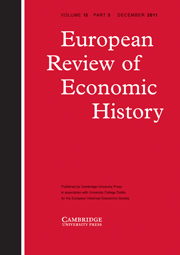Crossref Citations
This article has been cited by the following publications. This list is generated based on data provided by Crossref.
Peracchi, Franco
2008.
Height and Economic Development in Italy, 1730-1980.
SSRN Electronic Journal,
A'Hearn, Brian
Peracchi, Franco
and
Vecchi, Giovanni
2008.
Height and the Normal Distribution: Evidence from Italian Military Data.
SSRN Electronic Journal,
Schon, L.
and
Krantz, O.
2012.
The Swedish economy in the early modern period: constructing historical national accounts.
European Review of Economic History,
Vol. 16,
Issue. 4,
p.
529.
Malanima, Paolo
and
Pinchera, Valeria
2012.
A Puzzling Relationship.
Histoire & mesure,
Vol. XXVII,
Issue. 2,
p.
197.
van Zanden, Jan Luiten
and
van Leeuwen, Bas
2012.
Persistent but not consistent: The growth of national income in Holland 1347–1807.
Explorations in Economic History,
Vol. 49,
Issue. 2,
p.
119.
Jones, Geoffrey
van Leeuwen, Marco H.D.
and
Broadberry, Stephen
2012.
The future of economic, business, and social history.
Scandinavian Economic History Review,
Vol. 60,
Issue. 3,
p.
225.
Kelly, Morgan
and
O'Grada, Cormac
2012.
Agricultural Output, Calories and Living Standards in England Before and During the Industrial Revolution.
SSRN Electronic Journal,
Malanima, P.
2013.
When did England overtake Italy? Medieval and early modern divergence in prices and wages.
European Review of Economic History,
Vol. 17,
Issue. 1,
p.
45.
Kelly, Morgan
and
Ó Gráda, Cormac
2013.
Numerare Est Errare: Agricultural Output and Food Supply in England Before and During the Industrial Revolution.
The Journal of Economic History,
Vol. 73,
Issue. 4,
p.
1132.
Greasley, David
Madsen, Jakob B.
and
Wohar, Mark E.
2013.
Long-run growth empirics and new challenges for unified theory.
Applied Economics,
Vol. 45,
Issue. 28,
p.
3973.
ÁLVAREZ‐NOGAL, CARLOS
and
DE LA ESCOSURA, LEANDRO PRADOS
2013.
The rise and fall of Spain (1270–1850)1.
The Economic History Review,
Vol. 66,
Issue. 1,
p.
1.
Broadberry, Stephen
Campbell, Bruce M.S.
and
van Leeuwen, Bas
2013.
When did Britain industrialise? The sectoral distribution of the labour force and labour productivity in Britain, 1381–1851.
Explorations in Economic History,
Vol. 50,
Issue. 1,
p.
16.
Pezzolo, Luciano
2014.
The Cambridge History of Capitalism.
p.
267.
Bolt, Jutta
and
van Zanden, Jan Luiten
2014.
TheMaddisonProject: collaborative research on historical national accounts.
The Economic History Review,
Vol. 67,
Issue. 3,
p.
627.
Krakauer, Nir
2014.
Economic Growth Assumptions in Climate and Energy Policy.
Sustainability,
Vol. 6,
Issue. 3,
p.
1448.
Federico, Giovanni
and
Tena-Junguito, Antonio
2014.
The ripples of the industrial revolution: exports, economic growth, and regional integration in Italy in the early nineteenth century.
European Review of Economic History,
Vol. 18,
Issue. 3,
p.
349.
Henriques, Sofia Teives
and
Borowiecki, Karol Jan
2014.
The Drivers of Long-Run CO2 Emissions: A Global Perspective Since 1800.
SSRN Electronic Journal,
Felice, Emanuele
2014.
Handbook of Cliometrics.
p.
1.
Chilosi, David
2014.
Risky Institutions: Political Regimes and the Cost of Public Borrowing in Early Modern Italy.
The Journal of Economic History,
Vol. 74,
Issue. 3,
p.
887.
Pfister, Ulrich
2015.
The quantitative development of Germany’s international trade during the eighteenth and early nineteenth centuries.
Revue de l'OFCE,
Vol. N° 140,
Issue. 4,
p.
175.


